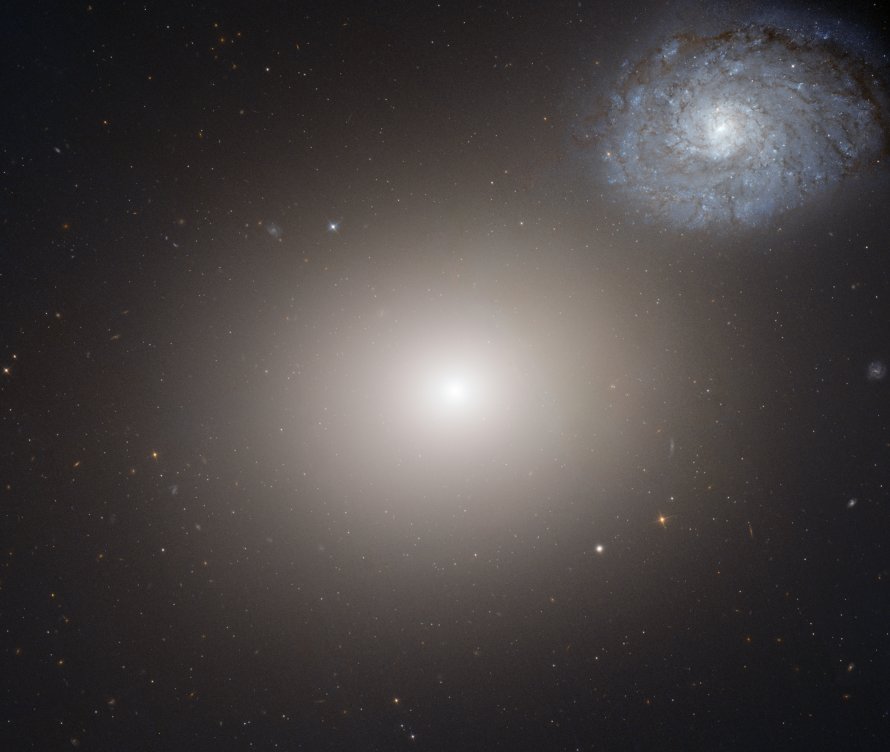M60 (NGC 4649)
Messier 60 (NGC 4649) is an elliptical galaxy located in the constellation Virgo in the Virgo Cluster of galaxies. M60 is 56.700,000 light years away from Earth.
M60 is best viewed during late spring, is magnitude 9.8, and can be viewed with small telescope. M60 is 7.4' x 6' in apparent size. For reference, the full moon is 30'.
Observing difficulty: Hard
- Name:
- Type:
- elliptical galaxy
- Constellation:
- Virgo
- NGC or IC:
- NGC 4649
- Magnitude:
- 9.8
- Viewing:
- small telescope
- Size:
- 7.4' x 6'
- Distance (light years):
- 56.700,000 LY
- RA:
- 12h 43.7m
- Dec:
- 11 34'
- Season:
- late spring
- Galaxy group:
- Virgo Cluster
- Messier Marathon #:
- 62
* The naked eye can see up to magnitude ~7-8 objects under ideal dark sky conditions.
An Illuminating Elliptical Galaxy in the Virgo Cluster
Messier 60, also known as NGC 4649, is a large elliptical galaxy situated within the constellation Virgo. As one of the dominant members of the Virgo Cluster, it presents an interesting opportunity for scientific study and amateur observation alike.
Historical Background
Discovered by Italian astronomer Giovanni Domenico Maraldi in 1779, Messier 60 is a particularly bright object in the Virgo Cluster, an agglomeration of galaxies relatively close to our own Milky Way. It later found its way into the famous catalogue of non-cometary objects compiled by French astronomer Charles Messier.
Physical Characteristics
Classified as an E2 type elliptical galaxy, Messier 60 is nearly spherical with only a slight elliptical elongation. It hosts a supermassive black hole at its core, one of the most massive known, with approximately 4.5 billion solar masses. This is indicative of the galaxy's robust history of star formation and dynamic activity. The galaxy is also known for its high population of globular clusters, estimated to be around 5,100, far more than our Milky Way's estimated 150-200.
Magnitude and Size
The apparent magnitude of Messier 60 is approximately 8.8, which places it just out of visibility range for the unaided human eye. However, with the aid of a small telescope or a pair of binoculars, this galaxy can be quite easily observed under dark skies. In terms of angular size, M60 spans approximately 7' x 6' (arcminutes), which is a significant size for distant galaxies observable from Earth.
Scientific Significance
The presence of a supermassive black hole in the center of M60 provides astronomers with a significant research opportunity. Studying its influence on the surrounding galaxy can offer insights into the complex interplay between galaxies and their central black holes. Furthermore, the high number of globular clusters is intriguing, providing a chance to understand these compact, generally spherical, star clusters and their formation.
Finding and Viewing Messier 60
Finding M60 requires locating the constellation Virgo, which is best seen during the spring months in the Northern Hemisphere. The galaxy is approximately 7 degrees west of the bright star Rho Virginis. When viewed through a small telescope, M60 will appear as a small, faint patch of light. With larger telescopes, the bright, concentrated central core and the elliptical halo of the galaxy become apparent.
It should be noted that Messier 60 is often seen in conjunction with the spiral galaxy NGC 4647. In low-resolution instruments, these two galaxies might appear as a single patch of light, while larger telescopes will resolve them as two separate entities.



